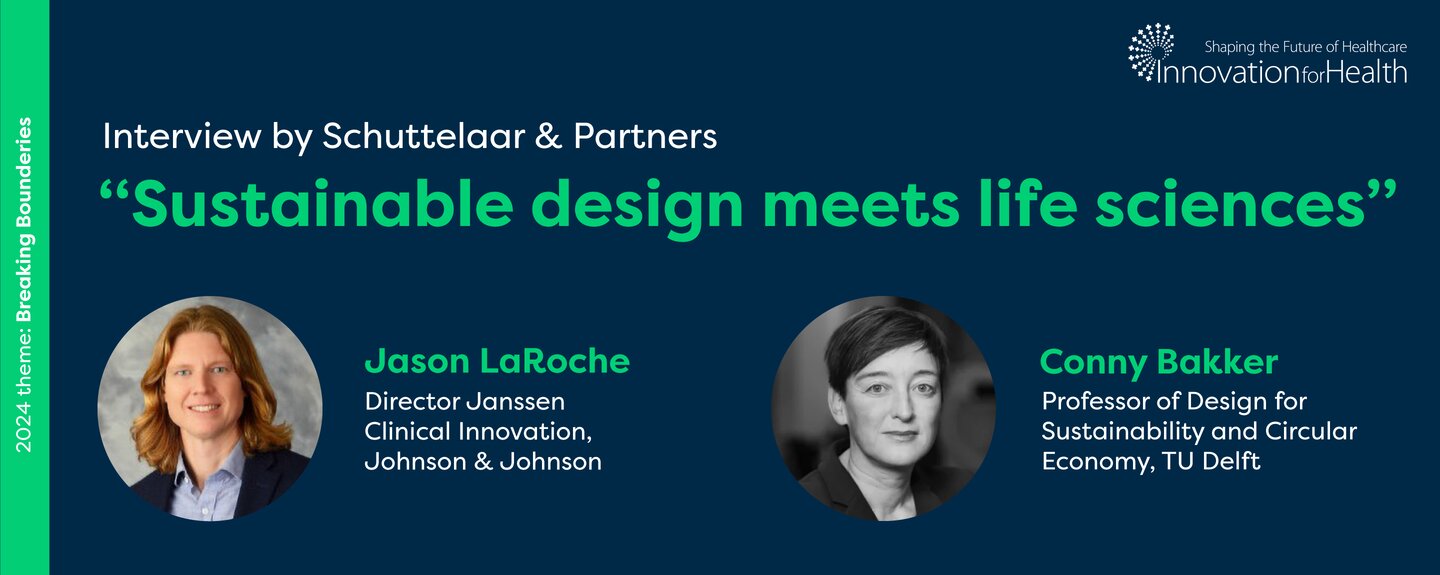Sustainable design meets life sciences
The greatest health risk for the future is climate change. That’s why, also within the Dutch life sciences community, reducing CO2 emissions is a priority. Prof. dr. Conny Bakker (TU Delft) is an expert in the science behind reducing the climate impact of all kinds of products and designing for sustainability. In her research group, Jason LaRoche (Johnson & Johnson) studies the climate impact of clinical trials and how best to reduce it. In anticipation for Innovation for Health 2024, we had a conversation on the why and how of reducing emissions in our sector.
From travel to e-waste
“The average commuting distance in our studies is 80 km. So, the biggest emission hotspot in clinical trials is patient travel to and from clinical sites. Digital health devices and telemedicine are possible ways to tackle this. I got involved in sustainable design when one of my colleagues started piloting a smart blister. We planned to recycle these smart blisters but found out this was impossible. Because the blisters were considered to be contaminated, they were incinerated. That’s when we connected with Conny.”
Conny sees that this is often the fate for over 85 million medical devices shipped yearly to the European market [1]. “Our own analysis shows that we are wasting about €150 million worth of critical raw materials like gold, platinum, lithium on a yearly basis. To find ways to recycle, reuse or refurbish these products, Jason started working with us on Life Cycle Assessments (LCA). When I started with sustainable design, there was no solid methodology. Now, I am very excited to see our methods being expanded in the field of healthcare.”
Climate change’s health burden
“A recent study pointed out that healthcare generates 2.6 billion tons of CO2 on a yearly basis [2]” says Jason. “If you consider the average health burden of climate change, this amounts to 600.000 excess deaths [3]. The pharmaceutical industry is in a strong position to reduce this impact. Now it’s important to improve our data and monitoring. With the recently established Sustainable Healthcare Coalition, we found willing partners in other companies, healthcare providers, and government bodies. Together, we share precompetitive data and insights, and collaborate to develop bold sustainability leadership for the broader healthcare sector.”
Conny is involved in the Alliance to Zero coalition, an association that aims to facilitate the transition of the pharma sector to compliance with net-zero emissions. In one of the projects, students investigated ways to reduce the footprint for one of the leading manufacturers of syringes and injectable devices. “Currently, most of these are single use: they are designed to be thrown away. These devices include surgical steel, medical glass, all kinds of plastics. With a disassembly robot, these can be taken apart and re-used. The students investigated ways to design injectors in such a way that these can indeed be disassembled. While this dismantling is destructive, the raw materials can now be recycled back into the system. These initiatives show how sustainable design benefits industry. The next step is to bring such initiatives out of academia, into practice.”
It is Jason’s job to implement such initiatives in practice, and he knows this can be complicated in the pharmaceutical industry. “If you want to change something, you need to consider that by making changes in the production or packaging of a drug, you have to revisit approval dossiers at regulatory bodies like EMA and FDA. Since patient safety and efficacy of our treatments is and always will be our top priority, this can create tension with our sustainability ambitions. We need to strike the right balance and have a careful conversation on how to implement sustainable design, whilst guaranteeing safety and efficacy.”
References
[1] Industry market sizing data, Deloitte Insights
[2] Health Care Without Harm, Arup. Health Care’s Climate Footprint, Green Paper Number One, September 2019. https://noharm-global.org/sites/default/files/documents-files/5961/HealthCaresClimateFootprint_092319.pdf
[3] Bressler R.D., The mortality cost of carbon, Univ. of Columbia, 29 July 2021, www.nature.com/articles/s41467-021-24487-w











